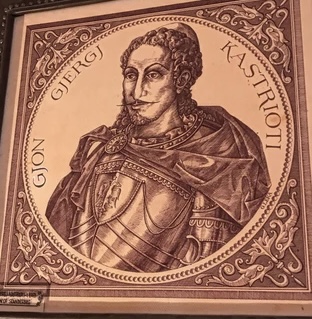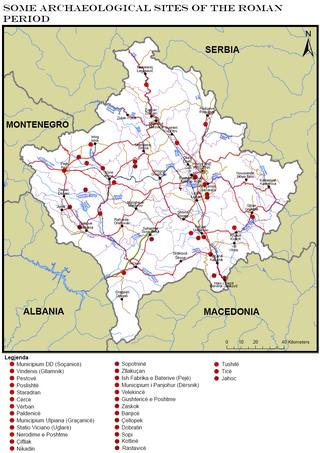
Skadarska Krajina, simply known as Krajina is a geographical region in southeastern Montenegro stretching from the southern coast of Lake Skadar to the mountain of Rumija, comprising several villages. It is inhabited almost entirely by Albanians. The area is divided between the municipalities of Bar and Ulcinj.

Albin Kurti is the Prime Minister of Kosovo, having been elected in March 2021 for a second time. He first served in the role between February and June 2020.

Radolišta is a village in the municipality of Struga, North Macedonia.
Rraboshtë is a village located in the former Kallmet municipality, Lezhë County, northwestern Albania. At the 2015 local government reform it became part of the municipality Lezhë. The village is situated near the river Drin, about 4 km north of the city Lezhë. Nearby mountains include Mali Kastriot and Mali i Velës.

Gjon II Kastrioti, was the son of Gjergj Kastrioti Skanderbeg, the Albanian national hero, and of Donika Kastrioti, daughter of the powerful Albanian prince, Gjergj Arianiti. He was for a short time Lord of Kruja after his father's death, then Duke of San Pietro in Galatina (1485), Count of Soleto, Signore of Monte Sant'Angelo and San Giovanni Rotondo. In 1495, Ferdinand I of Naples gave him the title of the Signore of Gagliano del Capo and Oria. While in his teens, he was forced to leave the country after the death of his father in 1468. He is known also for his role in the Albanian Uprisings of 1481, when, after reaching the Albanian coast from Italy, settling in Himara, he led a rebellion against the Ottomans. In June 1481, he supported forces of Ivan Crnojević to successfully recapture Zeta from the Ottomans. He was unable to re-establish the Kastrioti Principality and liberate Albania from the Ottomans, and he retired in Italy after three years of war in 1484.
Labovë e Kryqit is a settlement in Southern Albania, which has taken the name of its famous church, the Dormition of the Theotokos Church. It consists of two neighbourhoods: Labovë e Poshtme and Labovë e Sipërme. To distinguish it from its neighbour Labovë e Madhe, the village is known by two names Labovë e Kryqit, in reference to a nearby old Byzantine church and Labovë e Libohovës. It is part of the Qendër Libohovë subdivision of the Libohovë municipality, in Gjirokastër County, southern Albania.
Nicholas Dukagjini was an Albanian nobleman of the Dukagjini family in the 15th century. He was the son of Pal Dukagjini, one of the founding members of the League of Lezhë. Nicholas Dukagjini fled to Italy after the second Siege of Shkodra in 1479, but is well known for the return to his homeland two years later, together with Skanderbeg’s son Gjon Kastrioti and other noblemen to lead the armed movement against the Ottomans.

Part of a series of articles upon Archaeology of Kosovo
Rotino is a village in the Bitola Municipality of North Macedonia. It used to be part of the former municipality of Capari.
Rifat Hoxha is an Albanian author and historian. He was born in the village of Domën, just outside Kavajë, in the present-day municipality of Rrogozhinë. After completing high school studies in his hometown, Rifat enrolled at Tirana's Faculty of Philology where he graduated with a degree in languages and literature. He has participated actively in the literary life of Kavajë by publishing numerous books of historical character.

Šestani is a sub-region within Skadarska Krajina, in southernmost Montenegro. The region is a small mountain plateau of which terrace slopes towards the Skadar Lake. The region is predominantly populated by Albanians, many of whom are Muslims.
Dolna Lešnica is a village in the municipality of Želino, North Macedonia.

Dolna Ǵonovica is a village in the municipality of Gostivar, North Macedonia.

Arbinovo is a village in the municipality of Debarca, North Macedonia. It used to be part of the former municipality of Belčišta.

Bardovci is a village in the municipality of Karpoš, North Macedonia.

Vjosa Osmani-Sadriu is a Kosovar Albanian jurist and politician who has served as the 5th and current president of Kosovo since 4 April 2021.

Bajram Begaj is a politician and retired military officer, who is currently serving as the president of Albania since 24 July 2022. Having had a long career in the Albanian army, he served as the 26th Chief of General Staff of the Albanian Armed Forces from July 2020 to June 2022.
Skënder Anamali was one of the founders of Albanian archaeology. He made significant contributions to the field of Illyrian studies.

The Verboc Fortress known by local residents simply as Our Fortress is an Illyrian archaeological site located on a hilltop about 2 kilometers from the village of Verboc in Drenas Municipality, Drenica region, Kosovo. Today, it is a monument of Kosovo's cultural heritage with archaeological character.




















